Planned Palace of Gold Renovations
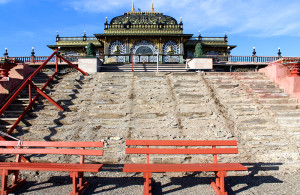
The Palace of Gold steps with the higher steps finished and lower steps in progress.
Thanks to our tireless construction teams 2015 was a productive year for New Vrindaban. In December of last year they completed an expansion to the parking lot located across from the temple entrance; bulldozing, leveling and shaping a first class parking area. Guests will now have ample parking to see the Palace and receive Prabupada’s mercy.
The steps leading to the Palace started renovation last summer, the upper portion is now complete. The stairs were expertly rebuilt by repurposing the original material for the risers, pier facings, and adding polished two-inch thick Absolute Black domestic granite for the treads and pier caps. The treads were flamed for traction and made extra thick for long-term endurance. Project manager Gopisa Prabhu mentions, “The end result is stunning and will soon be duplicated on the lower section of the front steps.”
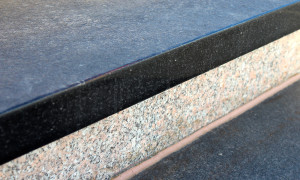
The Palace steps made with Absolute Black granite and flamed treads for traction.
During fall of 2014, the ISKCON New Vrindaban Board endorsed the renovation of Prabhupada’s Palace wall. Since then, the wall structure was stripped of its rock, siding, and though still standing strong, was filled with cement and stabilized with rebar on the inside to secure its structure. The next step is to layer the wall with EIFS material which is basically a combination of wire, stucco and plastic helping with insulation efficiency and the external appearance. Each column of the wall will be decorated on top with an original lotus pattern casted in concrete, while each section of the wall will hold newly casted window frames with their original design. This project is currently being organized.
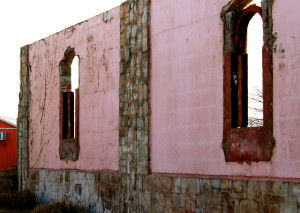
Prabhupada’s Palace wall is still being stripped of its brick and siding for renovation.
If there is room for more restoration projects, the red railing outlining the inside path entrance to the Prabhupada’s Palace will be renovated too. Gopisa Prabhu estimates the lower section of the stairs and the wall will be completed by the end of 2016.
Gopisa Prabhu also plans to fabricate the decorative wrought iron hand railings for the Palace steps this year as an offering to his spiritual master, Srila Prabhupada, for the 50th Anniversary of ISKCON. Gopisa Prabhu reflects by saying, “My hope is to be a productive tool in Krsna’s hands, after all, he is doing everything anyway.”
New Vrindaban Construction Plans for Spring
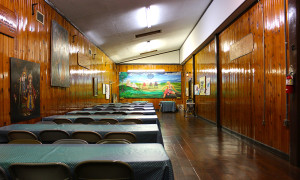
The main prasadam hall newly renovated.
Recently, New Vrindaban welcomed Bhagavan Bauer to the construction team as the Construction & Maintenance Manager for its current and future development. Bhagavan, along with core team John and Gintrist have been very busy since the end of last year, and this year is already packed with pending projects.
Bhagavan, born and raised in New Vrindaban, the son of Bhokta Prabhu and Sukhavaha Dasi, moved with his wife Ananga Manjari Dasi and his two sons Nava and Nitya, in October 2015 to New Vrindaban. The construction team is working on three main projects.
The first project was to lay beautiful new flooring in the guest prasadam hall, behind Jagannath’s alter, and renovating the guest kitchen. This started in mid-January and the flooring is now complete. The guest kitchen is still underway and will be completed soon.
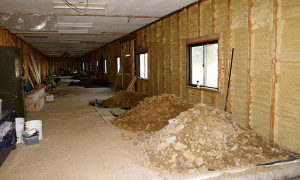
The nine Palace Lodge rooms under construction.
The second project is laying new floors in the main prasadam hall on the east side of the temple. This project was finished on Nityananda Triyodasi (Feb. 20th) including a fresh new layer of glossy paint on the wooden panels. Initially planning to install five skylights on the east side of the temple, a problem arose; Bhagavan and his team found excess ice and water inside the roof. Due to the damage and age of the roof, it is in dire need to be replaced and Bhagavan says replacing the roof will be done as soon as possible.
The third project in the works is creating nine rooms with attached baths under the east side of the lodge where Krsna’s Attic Thrift Store normally operates. The Thirft Store will be moved to the other side of the lodge. These rooms will be similar to the four rooms built on the other side of the lodge last spring. The aim is to finish the rooms latest for the Kuli Mela in June.
New Vrindaban construction is planning to build a maintenance workshop by the Community Garden (previously the Garden of Seven Gates) and new apartment buildings in the future (as well). This will provide the maintenance team an effective workshop for their tools, supplies, and a productive space when needed. In the spring they plan to fence in the outside playground area for children as well as finish the common rooms in both the men’s and ladies ashrams.
Stability and Strong Relationships Encapsulate New Vrindaban’s 2015
By Madhava Smullen
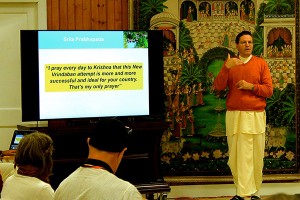
Jaya Krsna Prabhu introduces year 2015’s accomplishments.
“I am grateful to be able to serve in New Vrindaban,” said ISKCON New Vrindaban (INV) President Jaya Krsna Das, looking out at an audience of GBC, board members, temple residents, and community members.
He expressed the emotion as he introduced the Department Head Presentations on December 5th, part of the biannual INV and ECO-Vrindaban (ECO-V) Board Meetings.
Looking back with fondness on 2015, Jaya Krsna said that the past year had seen INV and ECO-V’s organizational structures, led by 14 department heads, become smooth and stable.
“We started out in 2011 with many new department heads,” he said. “Now most are experienced, and have strong, cooperative relationships with each other.”
He added that visitors could see INV improving on many levels, including its welcoming mood and the physical upgrades to its buildings and facilities. As a result, many senior devotees are now visiting, as well as large numbers of locals through events like Festival of Colors.
Other developments, he said, were showing that “Krishna’s magic” is in full swing.
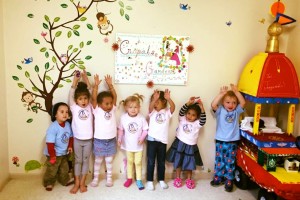
Students at Gopal’s Garden Preschool (October 2015).
On their own volition, community members Sundari Dasi and Mercy started the Gopal’s Garden Preschool. Devotees banded together to start the Village Association, which will give New Vrindaban residents more influence on how their community is run. Second generation devotees who grew up in New Vrindaban have moved back, like Nityananda Dasi with her husband Vrajadhama, and Bhagavan with his wife Ananga Manjari. And two other devotee families are about to settle on their own land sold to them by INV.
The Department Head Reports of 2015 followed Jaya Krsna’s introduction, highlighting the stability and cooperative relationships he had praised.
The Deity Department, headed by Abhinandana Das, reported making regular improvements in the standards of worship, cooking and dressing. Particularly exciting was the news that Deity outfits are again being homemade in New Vrindaban, which was once famous all over ISKCON for having the best seamstresses and jewelry designers. So too was the news that in 2015 the Deity Dept. hosted a Deity Worship Ministry Pujari training program for 48 East Coast pujaris for the second consecutive year.
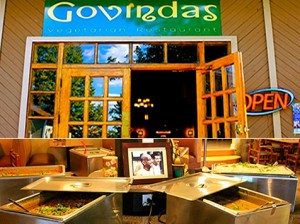
Govinda’s Restaurant in New Vrindaban is open seasonally (April-November).
From Govinda’s Restaurant, Vasudeva Das said that visitor numbers had notably increased throughout the year. This was probably due in no small part to the expanded menu, with world cuisine like sushi, tacos, and lasagna, as well as doughnuts, cakes, and vegan items. New décor was also added, including a book table; and increased kitchen space and a new altar made the atmosphere more pleasant for staff.
Vasudeva also presented for Madri Dasi from the Devotee Kitchen, who had to return home to Northern Ireland to be take care of an urgent family matter. Madri introduced a much-needed more healthy, balanced diet for the devotees, a consistent cooking schedule, and the use of ghee rather than oil. The Devotee Kitchen was also brightened up with a newly painted hallway and new doors.
Palace Lodge manager Gaura Bhakta Das, reported that the Welcome Center is beginning to fulfill its central role – it’s now receiving all the mail for ISKCON New Vrindaban; has warm customer service from senior devotees Lilasuka and Lokadristi, and has become the first stop for all visitors. Meanwhile in the Lodge itself, four new rooms with attached bathrooms – one of them wheelchair accessible – have been added, with nine more planned for this summer.
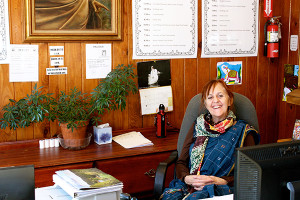
Lilasuka Dasi in the Welcome Center ready to give a warm welcome to New Vrindaban visitors.
“We’ve received a lot of positive feedback about the improvements in the facilities, and the way we take care of and welcome our guests,” says Jaya Krsna.
One newcomer to Krishna consciousness wrote to Jaya Krsna recently, listing the names of seven different devotees who had introduced themselves and talked to him.
Meanwhile in a Dandavats article, Taraka Das wrote that during his travels to various ISKCON temples, “The place that stood out for me as welcoming and warm was New Vrindaban. Every devotee that I encountered said, “Haribol. How are you?” or similar or just smiled. It warmed my heart!”
Another draw of New Vrindaban for visitors are its Festivals, reported on by Vrindavan Das. In 2015 hundreds participated in the Festival of Inspiration, the June and October 24-Hour Kirtans, and the Festival of Colors. Janmastami attendance tripled over the previous year, with 3,000 attendees. And devotees enjoyed a sweet community Rathayatra festival and an inspiring retreat with Bhakti Charu Swami.
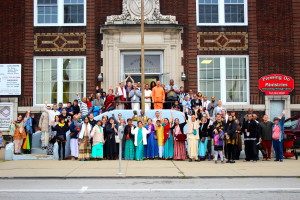
Above, devotees gather outside the YMCA building where Srila Prabhupada stayed in Butler, PA 1965 to honor the 50th Anniversary of his arrival in the USA.
Perhaps the highlight of the year, however, was the Srila Prabhupada’s Arrival Festival in Butler, PA, which saw 200 devotees tour the YMCA building where Prabhupada stayed, hold a huge Harinama on the way to the Agarwals’ old apartment, and praise the ISKCON Founder-Acharya in a Grand Ballroom event.
Vrindavan also presented the accomplishments of the Communications department, which had seven articles published in local newspapers about many of these festivals. Communications staff also improved the design and content of monthly email newsletter Brijabasi Spirit; created archives of New Vrindaban photos and articles from over the years; improved social networking; and published monthly articles on ISKCON News and Dandavats.
In Devotee Relations, Sukhavaha Dasi had a very busy year caring for residents. She offered personal development course The Hero’s Journey; had certified family life educator Krishnanandini Dasi give a couple’s course for future grihastas; and gave one-on-one counseling sessions to devotees with spiritual, emotional or financial challenges.
She also established a child protection team; brought ISKCON North American CPO Lilasuka Dasi to train its members; secured an apartment for a hospice for terminally ill devotees; and established experienced caretaker Jasoda Gokulananda to care for them.
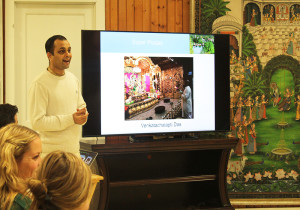
Gaurnatraj Das gives presentation on Congregational Development for 2015.
The Congregational Development department with Gaura Nataraj Das, meanwhile, is caring for pilgrims. They offer them a japa introduction course, a visit to the goshala, and a guided Govardhana parikrama when they visit, as well as a live weekly class via webcam. The CD team also keeps in touch with pilgrims at home, sending them gifts for birthdays and anniversaries, calling them up regularly, counseling them in their personal lives, and encouraging them in their chanting. As a result, registration increased by 25%, long weekend turnout by 50%, and 1,500 new familes visited New Vrindaban and registered with the CD office.
Of course, to ensure all these departments run smoothly, good Accounting is essential. In 2015 Laxmi Honest upgraded to a new bank, Chase, that makes transactions much more efficient; and a new, more reliable payroll company that ensures devotees get their direct transfers on time. She also ensured that monthly closing is done and financial data presented to the Board within ten days.
Moving up from the temple to Prabhupada’s Palace, Jaya Krsna reported for Tripad Vibhuti Das that visitors increased 10% to about 20,000 in 2015. In addition, the first chattra was repainted, its pillars replaced, and work begun on the second; the Rose Garden was set on its way to becoming sustainable and chemical-free; and monthly Prabhupada sangas were held in Srila Prabhupada’s altar room.
At the Apartments, new department head Lalita Gopi Dasi did a major cleanup of the building, planted flowers, and cleared the maintenance shed. She also had the toilets fixed, bathroom renewed and the stairs and decks renovated. “The devotee tenants are really happy with how helpful and supportive she is,” says Jaya Krsna.
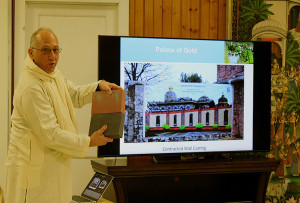
Gopisa Das demonstrates Prabhupada’s Palace wall development.
Finally in Facilities, Gopisa Das oversaw the infrastructure improvement that has drawn the appreciation of visitors. At Prabhupada’s Palace, he had the upper main stairs beautifully renovated by recycling the old pink granite, and adding new black granite treads with polished front edges. The parking lot was expanded from 15 spaces to 70. And contracts have been signed for a construction company to renovate the outer wall.
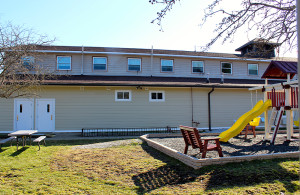
The Palace Lodge with newly replaced sidings, insulated doors and windows, and recently installed children’s playground on the right.
The Palace Lodge received a new floor in the community hall and attractive and durable new hardy board siding on the side facing the playground – which is also brand new and much safer for the children. The temple got insulated doors and windows to keep the heat in, an efficient gas furnace, a new roof over the guest wing with high quality lifetime shingles and Swiss Velux skylights.
Some of the cabins and apartments also received new roofs, the cracked sidewalks around the temple and Lodge were repaired, and two new apartment buildings are under construction.
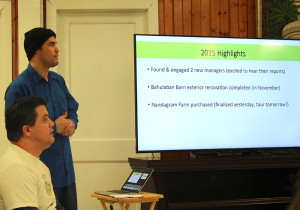
ECO-V Board Chair Bhima Walker summerizes the year’s highlights.
Next, introducing the ECO-Vrindaban department head presentations, ECO-V Board Chair Bhima Walker summarized the year’s highlights.
2015, he said, had been all about building the ECO-V team. Two new managers were engaged and brought up to speed: Project Manager Mukunda Das, who started in May, and Garden and Ox Training Manager Nitai Candra Das, who joined the team in September.
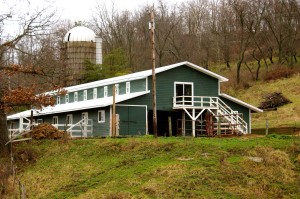
The newly renovated Bahulaban Barn completed in 2015.
Vyasasana Das completed exterior renovations on the once dilapidated Bahulaban Barn. It will now be used as a summer pasturing ground for retired milking cows and some of the elderly oxen.
The purchase of the former ISCOWP farm, which has been named Nandagram since the 1970s, was finalized the day before the presentations. The Nandagram Farm’s excellent ox training facility including barns and outbuildings — built over 20 years by Balabhadra and his crew – will be used to accommodate and train ECO-V’s three teams of young Brown Swiss oxen. The farm also includes two houses: one is already home to ECO-V Project Manager Mukunda and his wife Bhakti-lata, while the other will accommodate other staff members.
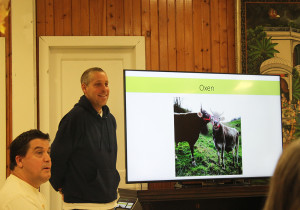
New Garden and Ox Training manager, Nitai Candra Das, introduces himself.
Following Bhima, new Garden and Ox Training manager Nitai Candra Das introduced himself. He described his four years of experience taking care of the ISKCON Escondido farm in California, which supplied local temples with vegetables and protected cow milk.
He then explained how he had put the New Vrindaban Community Gardens to bed for the winter; helped Vidya and her crew at the end of the growing season in the Teaching Garden; attended a restorative agriculture course with project manager Mukunda; and begun developing his relationship with the three ox teams. He hopes to have the oxen ready to take Prabhupada’s murti on a parikrama around New Vrindaban by fall 2016, and to take visitors by summer 2017.
Next Ananda Vidya Das reported steady success with the Cows. He and his wife Lalita Gopi are currently milking seven cows, with a yield of 17 gallons a day; keeping the Deity kitchen stocked with fresh butter, and even starting to make and supply ghee to the devotee and Deity kitchens. Two new calves, Shriya and Shiva, were born recently, and three more cows are pregnant and due in March.
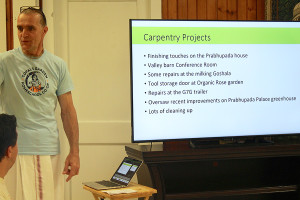
New Project Manager, Mukunda Das, describes his completed projects in 2015.
Last but not least was new Project Manager Mukunda Das. Mukunda described how he had overseen repairs at the milking Goshala and Palace Rose Garden, including a full renovation on the Rose Garden’s greenhouse with a new fan system, heaters, and electricity upgrade. He also fully renovated the long-neglected conference room at the ECO-Vrindaban Valley Barn, which will now be used for meetings on a regular basis.
Another major part of Mukunda’s work is community building – every week, he leads a number of ISKCON New Vrindaban department heads in exercises on how to deepen their relationships and interactions with co-managers, staff, and guests. He also serves as the chair and secretary of the Steering Committee that is developing the New Vrindaban Village Association.
“During previous years, ECO-Vrindaban spent a lot of time clarifying its mission,” says Bhima in summary. “2015 was all about building a team to realize that vision. And 2016 is the year we anticipate major progress in the gardens, ox training, and facilities upgrades.” He grins. “ECO-V is gonna make a splash!”
“In general, 2015 was a very successful year for both INV and ECO-V,” Jaya Krsna concludes. “We made a lot of progress on many levels. Now we have cooperative, stable teams which allow us to better serve Srila Prabhupada and Sri Sri Radha Vrindabanchandra. And that gives us a lot of potential for the future.”
Community Dialog Presents Plan for New Vrindaban Village Association
By Madhava Smullen

Village Association Meeting at Vyasasana and Lokadristi’s Home
Possibly the hottest topic at the Fall 2015 ISKCON New Vrindaban and Eco-Vrindaban Board Meetings, and certainly the one that drew the most interest, was the Community Dialog about a proposed new “Village Association.”
For decades, New Vrindaban residents have felt a need to be heard more by the ISKCON management and to have more influence on how their community is run.
So with a possible solution at hand, they were buzzing as they crowded into the Palace Lodge community hall after lunch on December 5th to learn more about it.
Longtime residents Nityodita Das and Advaitacharya Das guided the session, beginning with a half-hour Power Point presentation on the history and plan for the proposed Village Association.
The idea, they explained, has its roots in Srila Prabhupada’s 1973 statement, “We will establish a local self-governing village.” Varying attempts to make inroads towards this were made over the years, the most recent being the Advocacy Sanga — first launched in 2013.
Then, during the March 2015 board meetings, members of the INV and ECO-V boards themselves, led by Chaitanya Mangala and Jaya Krsna, encouraged the creation of an official Village Council, which would participate in the management of New Vrindaban from a broader “village” perspective.

Chaitanya Mangala Das introducing the New Vrindaban Village Association Concept
To do this, volunteers began the process by first forming a Steering Committee of seven. These included Jaya Krsna and Ananga Manjari (representing INV), Mukunda (representing ECO-V); and Advaitacarya, Nityodita, Devala, and Vyasasana, representing long term residents and broader community interests.
Over the next six months, the Steering Committee conducted many meetings with different interest groups in the village of New Vrindaban to develop their proposal. They then organized three larger gatherings – increasing in attendance each time from 20, to 40, to 60 people — where they continued to tweak the “blueprint.”
The version presented at the December 5th Community Dialog proposed a “New Vrindaban Village Association” made up of residents who would elect their chosen representatives to a “Village Council.”
The Village Council would then regularly meet with the ECO-V and INV boards and interact in a cooperative framework which is provisionally being called the “New Vrindaban Village Board.”
Advaitacharya and Nityodita explained that membership of the Village Association would be very open and inclusive, with the only requirement being that members must reside in the Ohio-Valley area.

Advaitacharya presenting a cooperative vision for a proposed Village Council.
“If you raise your hand and say, ‘I want to be a member,’ that qualifies you to be a member,” Advaita told the intrigued crowd.
The requirements to be a voting member aren’t much more restrictive: one need only be at least 18 years of age, an Ohio-Valley resident for at least one year, and attend at least one function of the Village Association per year.
In return, the Association aims to create a loving family environment among its members that helps to empower and assist devotees to live happily in and around New Vrindaban.
One priority will be to enhance fellowship and friendships amongst New Vrindaban villagers through regular spiritual and social group activities, such as men’s and women’s groups, youth groups, reading groups etc — a much-needed feature. Another will be to care for members by helping them understand housing options available and the land acquisition process, as well as by encouraging economic development through the establishment of local businesses.
And perhaps the most important facet will be to set up a system where concerns can be expressed, shared and addressed with action. This will help New Vrindaban residents feel cared for, and empower them with their desired participation in governing the village.
The system would likely see residents – soon to be members of the Village Association – address their concerns to their Village Council, who would then either handle the issue themselves or act as the go-between with ISKCON New Vrindaban or ECO-Vrindaban if it fell under the purview of either of those organizations.
The main difference would be a shift in expectations; not all the concerns of the Village would be funneled through ISKCON, allowing the temple – with its limited capacity – to act more as a spiritual center of the Village. This would reflect the fact that while residents and the two main non-profit organizations in New Vrindaban share many common concerns, there are some aspects that can be better handled in simultaneously cooperative and self-determined ways.

Nityodita explains the mission of the Village Association during the Community Dialogue.
“We need to break out of the old mindset of trying to use the legal structure of a religious non-profit in ways it was never meant to be used,” says joint-board member Chaitanya Mangala. “The analogy I use: If I went to the town of Moundsville, and said, ‘We’re now going to funnel all city management decisions through a local Church,’ everybody would look at me with a puzzled face and ask, ‘What are you talking about?’ Clearly, it doesn’t make sense. But that’s exactly what we’ve been trying to do for decades in New Vrindaban.”
After Nityodita and Advaitacharya’s presentation, the floor was opened up to an hour-and-a-half of discussion, beginning with everyone in the room getting the chance to express their feelings about the idea.
Many long-term residents, including Advaita himself, felt somewhat guarded, having seen multiple similar attempts fail in the past. They expressed that they were reserving their full enthusiasm for when and if the idea succeeded.
“Personally, I had never intended to get involved in something like this again – I had been through it too many times,” says Advaita. “But this time it came from the leadership outwards, saying, ‘Yes, we recognize this problem, and we know it really needs to be addressed.’ It’s the first time I’ve ever seen that, and that makes me hopeful.”
Some residents wanted more clarification on how the new structure would work. Board and Steering Committee members explained that this is a new, learning experience for everyone, that every detail has not yet been figured out, and that the mechanics will naturally be established over time with members learning as they go.
Others were concerned that the new Village Council would not really be on an equal footing with the other boards or have enough power to make things happen. In response, Advaita pointed out that the key to successful results is working together with trust and a cooperative spirit – something Srila Prabhupada stressed many, many times.
The qualities of patience, determination, and enthusiasm (utsahan niscayad dhairyat) – which Tamohara Das cited in Saturday morning’s Srimad Bhagavatam class – were also repeated throughout the Community Dialog and the weekend in general, as necessary qualities to practice in order to be successful in such efforts.
Finally, Board and Steering Committee members emphasized that differing viewpoints are all right, and in fact expected, as long as everyone maintains an underlying assumption of goodwill, and continues to communicate and cooperate with the shared goal of doing the best they can for the devotees, Srila Prabhupada and Krishna.
Overall, the mood of the Community Dialog was one of optimism, with many comments like, “I’m feeling enthusiastic,” “I’m enlivened to see things get this far,” and “I hope it will be successful.”
The Dialog concluded with the Steering Committee asking who would be open to joining the Village Association, and receiving a near unanimous show of hands.
Next up, the Steering Committee is planning a local event to officially launch the Village Association. Invitiations will include a print-out of the Power Point presented at the Community Dialog, along with membership applications. The event will feature entertainment, kirtan, prasadam, and a chance to sign up to get involved in community interests and concerns.
“I see this as a positive step, to paraphrase Srila Prabhupada, ‘In the gradual development of New Vrindaban as a self-governing village,’” says Chaitanya Mangala. “The previous culture, where every decision had to go through the ISKCON New Vrindaban management structure, disempowered individuals and put a huge burden on a handful of people. Distributing that load and increasing individual empowerment is necessary and will be incredibly beneficial for both local residents and ISKCON management.”
Third Service Appreciation Ceremony Warms Hearts
By Madhava Smullen
The Service Appreciation Ceremony – a semi-annual custom introduced in 2014 that honors those who have contributed years of service to the New Vrindaban village – was held for the third time at ISKCON New Vrindaban’s Community Hall on Sunday December 6th, 2015.
Previous ceremonies honored the late Madhava Gosh and his wife Vidya, Kripamaya and his wife Krsna Bhava, Malati Devi, Navin-Shyam, Jamuna, and Kacey Orr for diverse services from GBC to board member to cow and garden care.
This time, around fifty people gathered to honor ECO-Vrindaban veteran farmhand Ray Kuderski, cook and mother Dharmakala Dasi, performer and author Sankirtan Das, and his wife Ruci, a longtime teacher at New Vrindaban.
Joint board member Chaitanya Mangala Das acted as MC for the event, which for the first time included slideshow presentations on each honoree’s life and achievements.
Each person was also presented with a cherrywood plaque thanking them for their decades of service in the development of the New Vrindaban community, on behalf of Srila Prabhupada, Sri Sri Radha Vrindabana Chandra, and the Board of Directors of ISKCON New Vrindaban and ECO-Vrindaban.
Ray Kuderski – whose wife Kelli, son Michael, and sister-in-law Carol were all present – received his plaque from Ranaka Das, his boss and friend during his more than three decades of exceptional work with the cows and farming activities in New Vrindaban.
Born and raised in the Moundsville area, Ray didn’t have prior farm work experience, but learned on the job. He first began working with Ranaka in the Plough Department in 1983, which later merged with the Cow Care Department and eventually evolved into ECO-Vrindaban.
“For decades, it was mostly Ray and Ranaka doing everything,” says Chaitanya Mangala. “During the tougher times at New Vrindaban, when they had to look after 400 cows on a shoestring budget, they often had to put aside their own concerns and comfort to make sure the cows were cared for.”
The crowd laughed with fond familiarity when Chaitanya showed them a photo of Ray on his trusty John Deere tractor, commenting, “This is probably how you all recognize him.”
“Ray is known as a no-nonsense guy who does his work steadily without complaint year in and year out,” explains Chaitanya. “He’s been an amazing part of the fabric of New Vrindaban for so long. The place clearly wouldn’t be the same without him.”
True to form, when Ray was offered the chance to say a few words after his slideshow presentation, he declined with a self-effacing grin. But the crowd wouldn’t stay silent. One after the other, dozens got to their feet, praising Ray for his incredibly dedicated participation.
Next came Dharmakala Dasi, who has served New Vrindaban for more than four decades. After joining ISKCON in Maryland in 1972, Dharmakala was initiated by Srila Prabhupada in 1973 in New York, and began cooking for Krishna at the Henry Street temple there.
She moved to New Vrindaban in 1974, where she received 2nd initiation in 1975 and began cooking for the Deities and devotees, a service she would continue for the next fifteen years.
Her opulent 4pm offering of elaborate cookies and cheese cake became legendary, as did the breadsticks, date nut bars, apple crisp and more she made for the devotees. Often spending eleven-hour days in the kitchen, Dharmakala still found time to raise her five children.
After stopping her work in the temple kitchen, she continued to bake cakes for weddings, birthdays, and anniversaries in New Vrindaban, a service she offers to this day. In 1995, she started her company “World’s Best Cookie,” which has sold over 500,000 handmade cookies.
Speaking about their mother, Dharmakala’s eldest son Suddha-Sattva and daughter Dinataruni appreciated how she had opened her home to their friends. “Our house was always packed with kids, and you’d feed them every day,” Suddha said. “That’s one of the ways you showed your love for devotees in the community.” Dharmakala’s son Vincent and daughter Sarasvati were also present.
In turn, the crowd then showered their love and appreciation on Dharmakala, mostly by enthusiastically yelling out the names of her different legendary preparations. Some reminisced about fighting over her offerings; others thanked her for the cakes she had made for them. ECO-V Board Chair Bhima Walker then presented her with her plaque.
“My friends are the reason I’m still living in New Vrindaban after all these years,” Dharmakala was quoted in an article that was read out. “We all built this place together. We’re like family.”
Finally, Sankirtan and Ruci were honored. The two met in college in 1968, joined the Chicago temple soon after, and were initiated in 1973. They arrived in New Vrindaban on the eve of Gaura Purnima 1976 in the dead of winter, showing them just how austere the place could get. But nothing could deter them from serving there for the next four decades.
As well as her service to Tulasi Devi, Ruci is most known for her nearly forty years of teaching preschool and elementary students at different New Vrindaban schools since 1978.
Today, she continues to teach at the Gopal’s Garden Homeschool Co-Op, established in 2007. There, she provides a balanced blend of standard academic subjects and Krishna conscious ones, including japa, kirtana, and Bhagavad-gita slokas. At the end of each school year, she produces an anthology of the students’ writings and illustrations.
Over the years, Ruci developed bonds with her students that have remained to this day. She often receives mail from early students – now with successful careers and their own families – who tell her what an impact her teaching had on their personal and professional lives.
At the service appreciation ceremony, three generations stood to thank Ruci for everything she had done. Pioneer New Vrindaban residents told her, “You were a shining light throughout New Vrindaban’s history. You never let us down.” Their children, now in their thirties and forties, appreciated all the benefits they had gotten from her classroom. And their children, still currently studying with Ruci, piped up and said, “I love being in Ruci’s class!”
Meanwhile her husband Sankirtan is known for braving austere conditions out at the Bahulaban “Pits” to cook breakfast every day for nearly fifteen years, including the famed “oatwater.”
He’s perhaps most praised, however, for developing the Brijabasi Players and for his hundreds of plays and skits from the late 1970s to this day.
One of his most fondly remembered productions was the sweet Nandulal, in which he played the blind saint Bilvamangala Thakur, who unknowingly encounters Krishna, played by the then 12-year-old Sesa Walker. Sankirtan recalled the play as one of his favorite experiences from over the years, praising the professionalism and commitment of his youthful co-star.
Sankirtan also collaborated for many years with Lokamangala Das, performing transcendental dramas around the U.S. These included the two-man magnum opus Mahabharat, which they toured for four years to colleges, temples and even Off Broadway in New York City.
Sankirtan is also an award-winning storyteller and author, winning the West Virginia Artist Fellowship Award in 2005 for his storytelling at schools and colleges, and a Next Generation Indie Book finalist award in 2014 for his book Mahabharat: The Eternal Quest.
Recently, Sankirtan has been taking his PowerPoint about the 50th Anniversary of Prabhupada’s arrival in the West to colleges. And his project “Holding Srila Prabhupada,” in which he takes photos of pilgrims holding a picture of the ISKCON Founder outside his home – where Prabhupada stayed in June 1976 – has given hundreds a deeper New Vrindaban pilgrimage experience.
After the presentation on Sankirtan’s life, many devotees stood to say how moved they were by his service. Advaitacarya Das recounted how Sankirtan had spent eight hours a day for two weeks helping his son Halavah Sofksy rehearse to try and get an acting scholarship. As a result, Halavah won the scholarship. Present himself, Halavah added, “It shows the level of generosity that you have. And so many others have similar stories to tell about you.”
Sankirtan and Ruci also have two adult children of their own. Their son Josh (Sanjaya) – who was present at the ceremony — is an attorney and helps edit Sankirtan’s writings. Their daughter Visnupriya is a senior product and graphic designer for a consulting firm, and has designed and illustrated Sankirtan’s books.
At the end of the ceremony, Ruci and Sankirtan were presented with their plaque by INV board member Keval Patel.
In his concluding statement, Chaitanya Mangala recited Verse 4 from Rupa Goswami’s Nectar of Instruction, which discusses the six “symptoms of love shared by one devotee and another.”
He also quoted the purport, where Srila Prabhupada writes: “Even in ordinary social activities, these six types of dealings between two loving friends are absolutely necessary,” and further clarifies, “The International Society for Krishna Consciousness has been established to facilitate these six kinds of loving exchanges between devotees.”
“We don’t often just walk up to people we know and tell them our open-hearted thoughts and appreciations,” says Chaitanya. “So it’s important that we create spaces to facilitate this kind of sharing. When people do things to support and appreciate each other, it’s catching. The recipient feels good and then does something nice for someone else, and it causes a ripple effect.”
To finish off the evening, everyone had the chance to mill about and socialize with each other as they tucked into a delectable Ekadasi cake baked by Lakshman Das.
Plans are in place to continue the Service Appreciation Ceremony at New Vrindaban twice a year, well into the future.
Madhava Gosh Das (1949-2016)
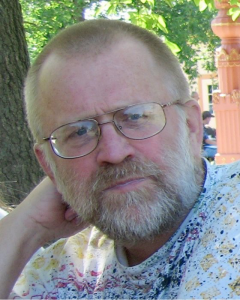
Madhava Gosh Dasa, born October 25th, 1949, left his body peacefully at his home in New Vrindaban, WV, on January 2nd, 2016, at the age of 66.
Madhava Gosh was a pioneer New Vrindaban inhabitant, having lived in the dhama since 1973. Inspired by the instructions of his spiritual master, Srila Prabhupada, he was a lifelong activist of local agriculture and cow protection and implemented an endowment fund to care for the cows at New Vrindaban.
Serving as one of the farm hands at New Vrindaban since the early days, Madhava Gosh spent decades of his life gardening and working on simple living projects.
When asked a month before he passed away what he felt was his best accomplishment he said, “Planting the trees, because the fruits are not enjoyed by the planter, but by those to come in the future. And these trees will outlive most of us.”
Madhava Gosh had a 10 year plan to plant 1,000 fruit and nut trees in the New Vrindaban dhama area, as part of the program for sustaining the Deities and devotees in the future, to provide perineal “crops” to produce food, year after year after year. Madhava Gosh planted with an assistant well over 350 trees since 2010. 150 trees were planted by householders living in New Vrindaban who take care of the trees. There are plans to resume this project in 2017.
Back in May 2006, Madhava Gosh had a liver transplant, due to his organ failing. His son Marken donated half of his own liver to sustain his father. Madhava Gosh did lots of service with his son’s gift and the “extra’ time.
The past two years Madhava Gosh has been struggling with post-transplant liver degeneration and other side effects. Both his kidneys failed and he had been on dialysis 3 times a week for over a year. With all the physical complications he was dealing with, he became weaker and weaker. He also came to understand that his lungs were already beginning to slowly deteriorate and filling with liquid.
Understanding that he was slowly dying and not wanting to be a burden on those caring for him, Madhava Gosh chose to go off dialysis on December 24th, 2015.
The week before his departure, Madhava Gosh’s daughter, Vraja, looked after his physical care. Many community members as well as some local neighbors visited Madhava Gosh. Devotees came and shared old pastimes and laughed with Madhava Gosh and expressed their hearts. They played instruments and sang and read Krishna book to Madhava Gosh. Srila Prabhupada’s singing was played non-stop for the last week.
Then on January 2nd, it seemed as if Krishna took direct control of all the events that followed, as everything seemed to be perfectly coordinated. The sun shined through the window. Three devotees, including Vraja, sat peacefully chanting by Gosh’s bedside while a recording of Srila Prabhupada and the Hare Krsna Temple album played in the background. That morning the samsara prayers were sung and then the Govindam prayers and some of the Brahma Samhita. Srila Prabhupada’s garland had been placed at Madhava Gosh’s head.
His daughter swabbed fresh Tulasi leaves from Sri Sri Radha Vrindaban Chandra’s lotus feet, sprinkled in the Ganges water into Gosh’s mouth. Madhava Gosh, who had not moved for 24 hours, suddenly lurched his right arm forward, and his right hand, which was inside his japa bag, grabbed his japa beads tightly. Gosh had a tear in his eye, took a labored breath. His daughter Vraja said, “It is OK, you can leave” and his next breath was his last.
Madhava Gosh left his body at 11:23 am, January 2, 2016. Srila Prabhupada’s garland was moved to encircle his face and neck. Shortly after his glorious passing, Srila Prabhupada was singing the Nrisimhadeva prayers of protection in the background.
Madhava Gosh is survived by his wife of 41 years, Vidya Dasi; five children, Manjari, Madhu, Vraja, Marken & Tulasi; three grandchildren, Mary, Gracie & Sydney; and many friends.
Those wishing to do something in honor of Madhava Gosh could plant a fruit, nut or flowering tree or contact ECO-Vrindaban at their Facebook page, which specifically funds the projects for the cows and garden care at New Vrindaban.
The community members are grateful that Madhava Gosh generously gave his time and energy to develop, maintain and preserve this New Vrindaban project. Thank you Madhava Gosh Prabhu, your spirit will live on through the fruits of your lifelong service contributions.
Srila Prabhupada & Kaliya, ISKCON’s First Cow
Written by Madhava Smullen. Archival Research by Chaitanya Mangala.
There’s no doubt that protecting cows was very close to Srila Prabhupada’s heart.
In a series of Back to Godhead magazine articles in the mid 1950s, he was already envisioning a community where residents lived a simple life and protected cows.
Soon after registering ISKCON in New York in 1966, he began requesting his disciples to start a rural community, asking them to call it “ISKCON-Nagari or New Vrindaban.”
And when Hayagriva Das, Kirtananda Swami and a handful of other devotees began New Vrindaban, ISKCON’s first farm, in 1968 in the hills of West Virginia, he urged them to keep cows and bulls there, and to maintain them comfortably throughout their natural lives as their proverbial mothers and fathers.
The cow’s milk could be used to create all kinds of staple foods, and their dung dried and used as fuel, he explained. Bulls could pull plows to till the ground for food grains. Together, they offered the chance of a peaceful, self-sufficient life free from the modern world’s stressful rat race and favorable for advancing in Krishna consciousness.
What’s more, he explained to Hayagriva in one of his first letters about New Vrindaban’s development, caring for cows was what Lord Krishna did every morning in Goloka Vrindavana. “Krishna by His practical example taught us to give all protection to the cows, and that should be the main business of New Vrindaban,” he said.
Prabhupada continued to write the New Vrindaban devotees nearly every month, espousing the benefits of cow protection along with outright entreaties for action.
“I am anxiously awaiting receipt of your first cow,” he wrote to Shyama Dasi in March 1969. And in April: “I hope you will soon be getting a cow for New Vrindaban. Vrindaban without cows does not look well, so we must have many cows as soon as possible.”
Devotees were glad to have finally purchased their first cow by the time Srila Prabhupada first visited New Vrindaban in May 1969. A black Jersey with a white mark on her forehead where Vaishnavas wear their tilak, she was named Kaliya, or “black,” by Prabhupada himself.
One of the first things the “Brijabasis” did when Prabhupada arrived was offer him a seat beneath a willow tree, and bring him fresh milk from Kaliya. They then sat around him in a semi-circle on the grass, looking up at him expectantly as he raised the cup to his lips.
Prabhupada was delighted. “I haven’t tasted milk like this in fifty years,” he said.
Excited at pleasing their spiritual master, the devotees brought Kaliya to meet him. Ranadhir Das paraded her before him, and Prabhupada admired her. “We don’t have such fatty cows in India,” he said. “In days past, yes, but now no one can feed them nicely. That is the way the Vedas calculate a man’s wealth—in cows and grains.” He even walked out to the barn to watch Ranadhir put Kaliya back in her stall.
During his visit, which lasted a whole month, Prabhupada continued encouraging the devotees, meeting with community leaders to discuss growing their herd from one to fifty. One cow’s milk could be shared by at least ten people, he said; or if each resident had their own cow, they could sell excess milk products and “get other necessities of life in that way.”
New Vrindaban and Kaliya stayed on Prabhupada’s mind after his visit. “I am always thinking of your New Vrindaban,” he wrote from Los Angeles just two days after leaving. “The first thing I find is the taste of the milk. The milk which we are taking here is not at all comparable with New Vrindaban milk.” He even offered to help finance more cows for the community.
Over the next few months and years, Prabhupada greatly enjoyed receiving in the mail curd cheese and milk sweets made from dairy provided by New Vrindaban’s protected cows; and he guided devotees in how to prepare them. “The whole idea of New Vrindaban is that men who are living there should produce their own food, of which milk is the principal thing,” he wrote.
After visiting New Vrindaban again in September 1972 to deliver a series of Bhagavat Dharma discourses, he was clearly enlivened by the progress he had seen. “I can see that Krishna is giving you more and more facility for developing this New Vrindaban scheme,” he said. “So this is very nice. I am very pleased that you have acquired some more cows.”
But he also cautioned the devotees not to forget about the bulls. “The cow is so wonderful and valuable in society,” he wrote. “But you should also use the bulls by engaging them in tilling the ground. People may call this the primitive way but it is very practical for engaging the bulls.”
By the time Prabhupada visited New Vrindaban again in July 1974, its cow protection program was thriving. There were 100 cows spread across three farms – Bahulaban, Vrindaban and Madhuban – including sixteen milking cows who produced over 600 gallons of milk per week. A fourth farm, Nandagram, housed young oxen, and three ox teams were being trained.
Prabhupada visited the Bahulaban barn, walking down its length and closely observing the cows on either side. He stopped at Shukla, whose milk he had also drank, and patted her on the head. He then observed the cow Satyabhama being milked, and when told that she was giving nine gallons daily said to cowherd Devakinandana Das, “You are doing wonderfully here.”
After his visit, Prabhupada wrote that he was “very happy” while in New Vrindaban and enjoyed the atmosphere, “especially the cow protection scheme.”
He continued to encourage the devotees to build a farm community that would set an example for how to treat cows: “Let other farms see… how we derive benefit from them and that will be the living example to persons who are using cow flesh rather than cow milk.”
In 1976, when he visited New Vrindaban for the last time, the community was caring for four working teams of oxen and over 150 cows. A new barn had been erected in Bahulaban, and Prabhupada visited it to see the cows and four new-born calves. He let one of them lick his hand as a devotee told him how the cows were yielding about 120 gallons of milk every day, which they were turning into ghee, cheese and buttermilk. Prabhupada was pleased.
But there was one cow he still hadn’t seen. Kaliya, now fourteen years old, was the retired matriarch of New Vrindaban’s herd. She had given birth to eight calves herself, and up until the previous year, had still been producing about six gallons of milk a day for the Lord and the devotees – despite having maladies common to aging cows of her breed, such as blindness in one eye and respiratory problems.
Writing in Brijbasi Spirit magazine, cowherd Amburish Das described how Kaliya – the smallest cow in New Vrindaban at 800 pounds – never pushed and shoved to eat grain as the other cows did, but stood patiently waiting her turn. “There may be some mild cows, but Mother Kaliya is even more than mild – she is a devotee,” he said. “Her humility is unmatched.”
This rare soul was finally reunited with Srila Prabhupada after seven years in a meeting that left an indelible mark in the minds and hearts of those who witnessed it.
Towards the end of his visit, Prabhupada walked with a large group of devotees to go see Sri Sri Radha Vrindaban Nath in the farmhouse temple at the old Vrindaban farm, where Kaliya resided. It was a beautiful morning, the rays of the rising sun shining hazily through a light mist.
As Prabhupada rounded a curve and spotted the Vrindaban farmhouse in the distance, one of the devotees, Advaitacarya Das, pointed to a small herd of cows far up at the top of “Govardhana Hill,” which rose to their left. “Srila Prabhupada, look!” he said. “There’s Kaliya. She’s our first cow. You used to drink her milk.”
Suddenly, as Prabhupada looked up at her, Kaliya broke away from her herd and made her way alone down the steep bank. Matching the devotees’ pace, she stepped out right in front of Srila Prabhupada, and began walking with him as if she were his pet calf.
“Ah,” Srila Prabhupada said simply. “My dear old friend Kaliya.”
She continued to walk with him for some time, a quiet connection hanging between them that the devotees all felt. Then, finally Kaliya picked up her pace and disappeared over the horizon.
“For me, it was a mystical experience,” says Advaita. “Srila Prabhupada was always preaching that we’re all trying to get to Vrindavana, where Krishna and his cowherd boy friends are eternally playing and taking care of the cows. And to see Kaliya come down the hill and walk with him like that just made it all very real.”
After this last visit to New Vrindaban, Prabhupada continued to encourage his followers to establish cow protection programs all over the world. And to all of them, he gave New Vrindaban as the model farm community to emulate – the home of Kaliya, the “Queen of New Vrindaban,” and ISKCON’s very first cow.
Madhava Gosh’s Memorial Service
Madhava Gosh Dasa, age 66, died peacefully at his home in New Vrindaban, WV, January 2nd, 2016, following a long struggle with post transplant liver failure.
He was a pioneer New Vrindaban inhabitant, having lived there since 1973. Inspired by the instructions of his spiritual master, Srila Prabhupada, he was a lifelong activist of local agriculture and cow protection.
Madhava Gosh is survived by his wife of 41 years, Vidya Dasi; five children, Manjari, Madhu, Vraja, Marken & Tulasi; three grandchildren, Mary, Gracie & Sydney; and many friends.
A memorial service will be held 10:30 am, Monday, January 4th, at the ISKCON New Vrindaban Temple. Friends are welcome at the service and the reception at the family home from 2:30 to 6 pm.
Gosh made two specific requests:
1. The memorial ceremony should start and end on time.
2. Those wishing to do something in his honor should plant a fruit, nut or flowering tree.
So, please show up timely and plant that tree!
New Year’s Resolution by Lakshmanesvara Dasa
Dear Devotees, friends, and well wishers.
I believe that the by gone year was pretty inspiring to be more introspective to our lives and practices to all of us reflecting our personal room for improvements in many folds. Every day we are trying to grow as better devotees, sincere servants, conscious human beings, and loving persons; we promise ourselves everyday to be better than ever. Srila Prabhupada describes this journey of excellence as “War against Maya”. It is definitely challenging but not impossible. The strength we draw to continue that ‘War’ when we stand together. That is one of the most important objectives of Srila Prabhupada and Sriman Mahaprabhu, to bring us together in Krishna Consciousness. Maya weakens us through five ways as follows:
When we are critical of others.
When we complain about others but refuse to take responsibility.
When we Compare persons with others.
When we compete with others for material gain.
When we fail to develop heart to heart communication in trust and contend.
2016 is bringing us another opportunity to start anew. So let us take vows to act different ways this year to make difference trough 10 emotional deposits in our inter and interpersonal relationships as follows:
1.Seek first to Understand.
2.Keep promises you make.
3.Be honest.
4.Be kind and Courteous.
5.Think Win-Win or No Deal.
6.Clarify Expectation.
7.Apologize.
8.Give and receive Feedback.
9.Learn to Forgive.
10.Be non-judgmental.
I wish you a very prosperous year. May Lord Krishna and Srila Prabhupada always bestow Their unconditional mercy upon you. Hare Krishna.
New Apartments in New Vrindaban to be Ready in Spring 2016
Exterior Design of New Apartment Building.
By Madhava Smullen
Two new apartment buildings, consisting of three apartments each, are being erected next to New Vrindaban’s community garden and are expected to be ready to rent by spring 2016.
According to ISKCON New Vrindaban president Jaya Krsna Das, they will fulfill an immediate need for more accommodation especially during the peak summer season.
But the additional accommodation is also essential in helping along New Vrindaban’s current phase of growth — many devotees are now returning to the community or moving for the first time with their families.
“If somebody moves to New Vrindaban,” Jaya Krsna says, “They need a place to stay while they work on buying land and building their own house.”
The apartments aren’t just cheap temporary accommodation; ISKCON New Vrindaban is aiming for the highest construction quality within its budget.
Each of the two buildings will include a one-bedroom studio apartment in the basement, a two-bedroom on the first floor, and a three-bedroom on the second floor. They’ll acccommodate single people, smaller and larger families respectively. And they’ll each come with comparatively-sized, temperature-controlled storage spaces located in the basement.
The buildings are being constructed by PennKraft, a Western Pennsylvania company that prefabricates modular homes at its factory and then assembles them onsite. Quality is the same as with an onsite home, with the advantage that factory construction conserves materials and is thus more environmentally-friendly. It’s also faster, more efficient, and protected from the elements.
The foundations will be made with Superior Walls, a precast concrete system with insulated wall panels often used in green home construction. This will save energy, keep out the cold and make for an overall stronger structure.
“We’ll also use hardy board siding, which is very durable,” says construction manager Gopisa Das. “Then, in between the units, we’re using Roxul, a mineral wool that serves as both an insulator and a sound deadener.”
Meanwhile the buildings will each have insulated exterior doors to provide the best thermal barrier possible, a 50-year metal roof, and high-quality energy efficient windows that will keep the heat and cool in.
Inside, each apartment will have its own individual electric heating and cooling system, which is the rental standard and a safer option than gas.
The interior doors will be solid core oak with red oak trim, the floors a very durable solid vinyl plank, and the kitchen cabinets solid maple. Each apartment will have LED lights, which consume up to 90% less power than regular incandescent bulbs, and its own individually-controlled heating system.
Care is being put into selecting the fixtures and appliances, too.
“We’re using Schlage locks and American Standard faucets, which you only see in commercial kitchens and last virtually forever,” says Gopisa. “For appliances, we’re installing the same fridge I have at home, a Samsung side-by-side stainless steel refrigerator with the freezer underneath and very high efficiency, along with matching Samsung electric stoves.”
Outside the buildings, there will be parking for residents. And to fit in with the New Vrindaban mood and lend a uniform look to the entire masterplan, the buildings’ entrances will feature ornate columns and the same Jagannath chakra that adorns the roof of Sri Sri Radha Vrindabanchandra’s temple.
Despite the first-class construction, rent will range from only $550 to $850 depending on the size of the apartment, with water, waste water, and road maintenance included. “We’re aware of the concerns about pricing, and we wanted to make sure the accommodation was affordable to the devotees,” says Jaya Krsna.
The apartments will be constructed using a loan from Eco-Vrindaban. The plan is for both the interest and principal to go into an endowment fund for the long term care of cows in New Vrindaban.
The new apartments are the beginning of a thirty-year plan that includes thirty apartments in total, plus twenty townhouses and ten new cabins.
These additional buildings, as well a new access road connecting directly with the public road, will be constructed over the next thirty years as the need for them arises.
“This is the first time since the milk barn was erected near the temple in the 1990s that ISKCON New Vrindaban is constructing a new building,” says Jaya Krsna. “So it’s really a big step for our community as it moves into a new phase.”
Three things, according to Jaya Krsna, are needed for a community to grow: a school, jobs and accommodation.
“We have the Gopal’s Garden Homeschool Co-Op,” he says. “We have a number of very nice services to do for the temple, several devotee-run companies offering jobs, and a planned retreat center that will create additional jobs for devotees.
“Now we need more accommodation where devotees can live. Facilitating younger devotees with families moving to New Vrindaban in this way is an important step in our succession plan, and in the rejuvenation of the community itself.”
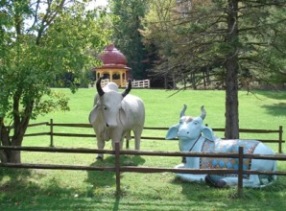
Welcome to Brijabasi Spirit
Thank you for taking the time to visit the New Vrindaban community blog. Think of visiting our blog as making a virtual pilgrimage.
Hare Krishna Hare KrishnaKrishna Krishna Hare Hare
Hare Rama Hare Rama
Rama Rama Hare Hare
"May cows stay in front of me; may cows stay behind me; may cows stay on both sides of me. May I always reside in the midst of cows."
Hari Bhakti-vilas 16.252






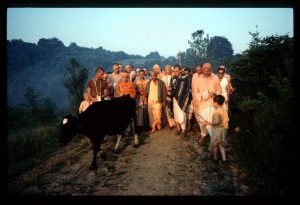
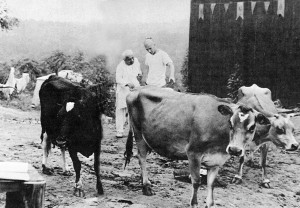
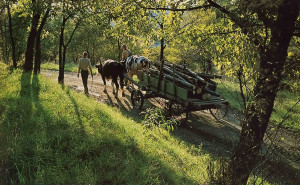
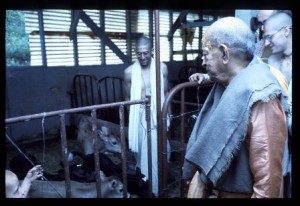









Recent Comments